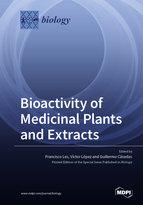Bioactivity of Medicinal Plants and Extracts
A special issue of Biology (ISSN 2079-7737). This special issue belongs to the section "Plant Science".
Deadline for manuscript submissions: closed (30 April 2021) | Viewed by 96574
Special Issue Editors
2. Instituto Agroalimentario de Aragón-IA2, CITA-Universidad de Zaragoza, 50059 Zaragoza, Spain
Interests: natural products; phytochemistry; antioxidant activity; herbal medicine; biological activities; adipose tissue; enzyme inhibitors
Special Issues, Collections and Topics in MDPI journals
Interests: natural products; functional foods; medicinal plants; bioactive compounds; polyphenols; anthocyanins; antioxidants; enzyme inhibitors
Special Issues, Collections and Topics in MDPI journals
2. Instituto Agroalimentario de Aragón-IA2 (CITA-Universidad de Zaragoza), 50059 Zaragoza, Spain
Interests: natural products; berries; neuroprotection; anthocyanins; antioxidants; cell culture
Special Issues, Collections and Topics in MDPI journals
Special Issue Information
Dear Colleagues,
Medicinal plants and natural products have played a central role in therapeutics, being considered the origin of Pharmacy and Pharmacology. Plants are still a source in nature to obtain and isolate molecules with pharmacological applications (drug discovery) but can also be used as herbal medicinal products in traditional or complementary medicine.
In addition, the WHO has launched a Traditional Medicine Strategy (2014–2023), including herbal medicines as medicinal therapies, with the aim to ensure the quality, safety, proper use, and effectiveness of traditional medicines, among other objectives.
For all these reasons, this Special Issue on “Bioactivity of Medicinal Plants and Extracts” includes a collection of original research and review articles on new advances in the development and application of bioactive compounds and extracts from plant matrices.
Dr. Francisco LesDr. Víctor López
Dr. Guillermo Cásedas
Guest Editors
Manuscript Submission Information
Manuscripts should be submitted online at www.mdpi.com by registering and logging in to this website. Once you are registered, click here to go to the submission form. Manuscripts can be submitted until the deadline. All submissions that pass pre-check are peer-reviewed. Accepted papers will be published continuously in the journal (as soon as accepted) and will be listed together on the special issue website. Research articles, review articles as well as short communications are invited. For planned papers, a title and short abstract (about 100 words) can be sent to the Editorial Office for announcement on this website.
Submitted manuscripts should not have been published previously, nor be under consideration for publication elsewhere (except conference proceedings papers). All manuscripts are thoroughly refereed through a single-blind peer-review process. A guide for authors and other relevant information for submission of manuscripts is available on the Instructions for Authors page. Biology is an international peer-reviewed open access monthly journal published by MDPI.
Please visit the Instructions for Authors page before submitting a manuscript. The Article Processing Charge (APC) for publication in this open access journal is 2700 CHF (Swiss Francs). Submitted papers should be well formatted and use good English. Authors may use MDPI's English editing service prior to publication or during author revisions.
Keywords
- Medicinal plants
- Herbal medicines
- Bioactive compounds
- Pharmacognosy
- Plant extracts
- Polyphenols
- Ethopharmacogy
- Essential oils
- Aromatic plants
- Antioxidants
- Natural products
- Phytochemicals









